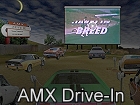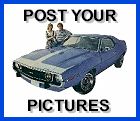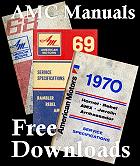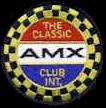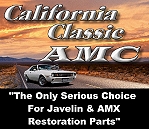Site Tools & Extras
Quick Links
1968-1972 Trans-Am Racing
Trans-Am Racing 1968
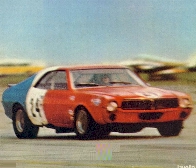
Rugged proving ground of car stamina, performance and racing team skill
LET'S GO TO A TRANS-AM RACE.
Let's see what makes Trans-Am championship racing so exciting and in many ways more demanding than any other form of racing. You take your place in the grandstand or you may picnic on one of the knolls where you have a good view of the course. One look tells you this will be a different kind of race than you have ever witnessed before. The road course has an infinite variety of turns, straights, surfaces and tough braking situations. On the straightaways, the drivers can push their cars well over 150 mph. Then, there are right and left turns, much sharper than you see on the high speed oval tracks where usually the stock car that can turn left fastest for the longest time without breaking down wins the race.
SPEED ALONE NOT ENOUGH. However, speed alone won't make a winner at a Trans-Am race. It's handling that really counts. Handling, because the turns are sometimes within a few feet of each other. Some are called "switchbacks", turns that are at such a severe angle the car practically makes a full 180' turn and starts coming back in the same direction that it was going. It's not unusual to see a driver brake his car to 20 miles per hour to safely negotiate one of these turns.
THE TRANS-AM CAR. There are 2 classes of cars . . . the under-2-liter engine class and the 2 to 5 liter engine class. In the over-2-liter class only four passenger "sedans", with 116" maximum wheelbase and a minimum weight of 2,800 lbs. are eligible. One of the requirements that appeals to performance-minded buyers is that the special equipment used on Trans-Am cars must be available through the manufacturers' authorized dealers or from speed equipment manufacturers.
Two Javelins have been equipped to race in the over-2-liter and under-5-liter engine classification which permits a maximum of 305 cu. in. engine displacement. The Javelins have basic 290 CID V-8 factory engines that are bored out to 304.3 cubic inches to obtain maximum performance within the displacement limit.
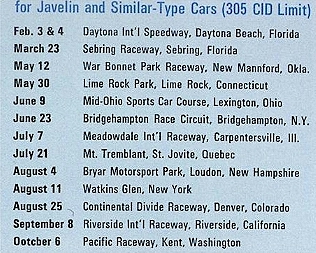
THE BIG CIRCUIT. Trans-American racing is just that. Trans-American. The 13 scheduled Trans-Am Sedan races range from coast to coast, border to border. The circuit takes you from the extreme Northeast up at Bryar Motorsport Park in New Hampshire to the extreme Southwest at the classic Riverside International Raceway in Riverside, California. From the extreme Northwest at the Pacific Raceway in Kent, Washington to the extreme Southeast in Daytona Beach, Florida. And to a lot of very scenic country in between. There's even a Canadian event up at Mt. Tremblant, in St. Jovite, Quebec.
Some are distance races in that the winner is the first car to complete a prescribed number of laps. This is the case, for example, in the 75-lap.challenge at the Meadowdale International Raceway in Carpentersville, Illinois. Most, however, are time races in which the winner is the car with the greatest number of laps after a prescribed time period. These time periods vary from the 2 1/2-hour stint at famed Watkins Glen in New York to the marathon 24 hour grind at the Daytona International Speedway in Florida.
Points are awarded for winning and placing positions and are cumulative from race to race. The Trans-Am circuit then is like a single giant race with 13 parts that continue from early February until early October. Out of the 13 races, each competitor is permitted to select his ten best finishes for his final score.
Each race has its own peculiarities, makes its own particular demands upon car and driver. But all have one thing in common. They're tough.
Javelin... Cinderella Car of the 1968 Trans-Am Racing Circuit
The 1968 Trans-Am season saw a new competitor in sedan road racing, one that in its rookie year displayed its muscle with amazing speed and stamina. As a result, the first Official American Motors racing team has proved that its specially prepared Javelin can compete with the best in the fast Trans-Am racing circuit. It is posing a serious challenge to car makes that have been dominating the circuit for years.
In the first five races since its competitive debut at Sebring, Fla., Javelin matched defending Trans-Am titlist Mustang in piling up manufacturer's championship points.
Dating from Sebring's 12-hour run, Javelin and Mustang each accumulated 22 points on the basis of a 9-6-4-3-2-1 point-formula for each event. It takes more than a hot machine to be a contender in today's road racing circles. It takes people ... the right people. And the Javelin success team story starts right at the top.
The Javelin Success Team
American Motors' brisk new management, headed by board chairman Roy Chapin, Jr. and president Bill Luneburg, knew it had a fine automobile in the new Javelin. The problem was how to demonstrate the fact. They turned to big time road racing because it is more demanding than racing on the fast oval tracks where many American stock cars compete.
To do this, the Javelin Racing Team, Inc. was established with Jim Jeffords as president and Ron Kaplan as vice president. Both men brought a lot of racing know-how to their new jobs.
Jim created the famous "Purple People Eater" Corvette team in 1958 and drove to victories in 27 out of 30 SCCA races, and was B Production champion in both 1958 and 1959.
JRT vice president Ron Kaplan was the man responsible for keeping Jeffords' Corvettes and Scarabs running so well, and has been solely responsible for all preparations of the two 1968 Trans-Am Javelins.
For drivers, American Motors turned to Peter Revson and George Follmer.
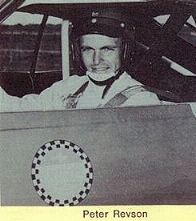
At 29 years of age, Revson already has five years of professional International competition under his helmet along with four years of amateur racing. The highlight of his 1967 season was the winning of the SCCA Jim Kimberly Cup.
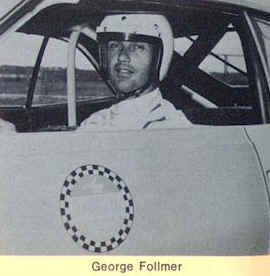
George Follmer, 34, is an extremely versatile driver, having competed in almost all types of car racing -Trans-American Sedans, Group 7 Sports Cars, Stock Cars and Indy Roadsters. In 1965, George surprised the road racing fraternity by copping the U. S. Road Racing Championship with a two liter car.
All in all, it's quite a team. A team destined to make the distinctive red, white and blue Javelin racing stripes the colors to watch in 1969.
Sebring
"The in-crowd, those in the know, laughed out-right at American Motors coming here, in fact some smirked Javelin was D.O.A., Dead On Arrival". AMC would debut its all new pony car at the tough 12 Hours of Sebring.
By Pete Waldmeir
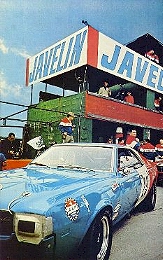
Once you've been there during race week, you never forget it.
Mention the name and you can feel the grit of sand in your hair and hear the ear-splitting scream of a high-performance engine unwinding as a racer approaches a sharp right-angle turn after a sprint down one of the long straightaways.
Sebring is pretty girls and greasy mechanics. It is a man running through the pits carrying a wide, black racing tire that has been shredded to pieces in a high-speed blowout. It is a baby sleeping peacefully in a perambulator parked in the shade of an upraised auto hood.
Sebring is more. It is the famous names of auto racing-Juan Manuel Fangio and Wolfgang von Tripps; Sterling Moss and Phil Hill.
For 18 years, the Grand Prix of Endurance, the 12 Hours of Sebring auto race, has been held on the 5.2 mile airport course outside the tiny central Florida town which is some 85 miles south of Tampa and 160 miles from bustling Miami.
Each winter for the last 18 years the town has awakened to receive nearly 100,000 visitors-spectators, owners, drivers and mechanics-for a week of the best racing in the western hemisphere.
The drivers and owners come to race because Sebring is the nearest thing to a European sports car circuit to be found in the United States. It is a test of man and machine, a proving ground, the place you go to get started in racing and the place you go to reach the top.
For the first time this year American Motors went to Sebring in force, to compete in the Trans-American championship division against Mustangs, Cougars and Camaros.
Two cars were entered by the Javelin Racing Team, which is headed by a former racing driver from Milwaukee named Jim Jeffords. The Team Javelins were prepared for the track by Ronnie Kaplan Engineering, of Chicago, with engines by Traco Engineering, of Los Angeles.
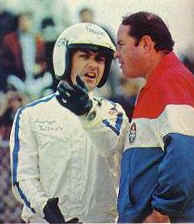
Peter Revson and Skip Scott led the team which drove one of the Javelins; George Follmer and Jerry Grant led the other.
It was a beginning and it was modestly successful. The Javelins were entered in the Trans-Am class for "sporty sedans"-with engines under five liters in size-and the Revson/Scott car finished fifth in its class and 12th overall in the 68-car field. Only 36 cars finished. The Follmer/Grant Javelin ran strong for six hours before retiring with a broken valve.
The results were pretty astounding. For one thing, the Javelins were powered by the basic American Motors 290-cubic-inch engine which had been bored out to 304.3 cubes.
And it was the first race for the Javelin on the Trans-Am circuit.
Bill McNealy, American Motors marketing vice-president who watched the entire operation, summed up the AM attitude. "We did remarkably well," said McNealy, "when you figure that we started racing five years behind everyone else."
Carl Chakmakian, performance activities manager, said "Remember, we accomplished all this with a single carburetor against our competitors' dual-carb manifolds."
Most owners and drivers feel their trip to Sebring is a success if (1) they get to take a hot shower sometime during the week, and (2) if they can finish the race. Not win, finish.
The word that best describes the 12 Hours of Sebring is "Proof!"
All cars start at the same time. No matter what the class (i.e., how big the engine, how small the car), the car and driver who finishes the most laps in the 12 hours between 10 a.m. and 10 p.m. is the winner.
Despite the fact that there are 14 turns demanding some 20 gear changes on the 5.2 mile course, which has been described by veteran drivers as a "series of drag strips connected by corners," the Javelins consistently turned laps of 100-plus miles an hour.
The Javelin driven by Peter Revson, the 29-year-old veteran from New York City, was stymied early in the race when it stalled and stopped in a far corner of the course because of a fuel problem. The car got going again, however, after Revson ran all the way back to the pits for help.
No one knows the pitfalls of Sebring better than promoter Alec Ullman, a Russian-born MIT graduate who started the race in 1950 in an attempt to rejuvenate sports car racing in the U.S. The town of Sebring welcomed the race with open arms. There were more bats in the hotel hallways in those days than customers. The 1951 race was a real endurance test. Fourteen cars finished out of a starting field of 65.
That's why today a car is listed among the finishers if it merely can complete 70 percent of the total laps of the winner.
Many of the best cars, and the best drivers, didn't last the 12 hours this year. Veterans like Lloyd Ruby, Jochim Bonnier, Jackie Ickx, Pedro Rodriguez, Lucien Bianchi had that hot shower by the time the race ending fireworks burst over the pits at 10 p.m. and Alec Ullman's wife, Mary, bestowed the traditional kiss on the victor.
The Team Javelins were prepared for everything. But they got a little unexpected extra luck. In the pit assignments, Javelins were given the first two at the entrance to pit row. In 1965 the same pits were assigned to another Sebring newcomer -the fleet Chaparral, driven by Hap Sharp and Jim Hall-and it turned out to be a winner.
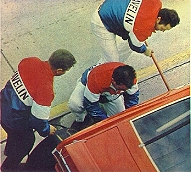
The Javelin's practice times were competitive. The car driven by Follmer, a 34-year-old veteran pilot of sports cars and Indy championship racers from Arcadia, Calif., qualified at 101.52 miles an hour. The Revson car checked in officially at 100 mph.
The times qualified both cars high on the 68-car grid for the Le Mans type start on Saturday morning. Shortly before 10 a.m. all drivers lined up across the track from the pits. Their cars sat several feet away, the engines silent.
At 10 o'clock Ullman shouted the race into being and the drivers sprinted across the track, jumped in and turned the ignition. Some started, some didn't. Peter Revson and George Follmer were away in a flash, even after fastening their safety belts.
Some high-speed stock and Indy car races are tests merely of machinery. The car that can turn left fastest for the longest time without breaking is the winner.
At Sebring the turns are right and left, sometimes within a few feet of each other through the "Esses," which are a mid-course chicane. There is repetitive acceleration and severe braking plus suspension ending turns.
Spectators crowd the hairpin turns after dark to watch the cars' disc brakes glowing red-hot through their ventilated mag wheels.
If you are in racing, Sebring-and the other widely scattered courses of the intriguing Trans-Am circuit is the place to be.
What's a little sand in your hair?
PETE WALDMEIR is the sports columnist of the Detroit News and a contributor to Sports Illustrated.
Press Time News
The two Javelins featured in the preceding Sebring article finished second and fourth in their second Trans-Am race at War Bonnet Raceway, near Tulsa, Oklahoma. The Javelin driven by George Follmer finished in the same lap as the winning Camaro, two laps ahead of the third place Mustang driven by Parnelli Jones. The fourth place Javelin with Peter Revson behind the wheel was in the same lap as Jones' Mustang. More than 10,000 spectators witnessed the spectacular performances of the Javelin newcomers.
The Race for Second
With the points Championship already in the Chevrolet bag, you would have thought the rest of the cast had given up until next year. You would have been wrong.
By Eric Dahlquist Motortrend, December, 1968
Submitted by Chris at www.mopars.com
When you are an American, you play to win. No other finish counts. Curious, then, that on Sept. 8, 1968, on the parched range of Riverside International Raceway, Ford Motor Company and American Motors Company were locked in a struggle to gain the coveted, for this season only, second place in the Trans-American Championship for over 2-liter cars. Chevrolet had already won it. Two races before at the tip of Lake Seneca in Watkins Glen, New York, Mark Donohue, Media, Pennsylvania issue of the all-American boy put the series away. Strapped into Roger Penske's blue Sunoco sizzler, the Penske-Hilton-Donohue Camaro droned on to eight back-to-back victories with the cool efficiency of a crew of IBM data processors. A clear margin of 20-50 horsepower on the field most of the season had something to do with it, too. So, as of Riverside, Chevy was safe at goal with 93 points, Ford had 50, AMC 45 and, either Dearborn or Kenosha could axe the other here or at Kent, Washington, the last meeting.
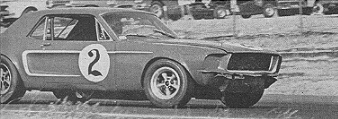
Eight months before, as Jerry Titus savored his Mustang victory in the 24 Hours of Daytona, the specter of Ford getting put down by anybody, much less American Motors who had no cars even in the field yet, seemed a remote prospect indeed. The Javelins, prepared by Ronnie Kaplan, engined by Traco and driven by George Follmer and Peter Revson, appeared on the Sebring scene six weeks later with a single 4-barrel carburetor and a lot of confidence in potentially competitive but untested cars. Seven races later, they were living out the "impossible dream," leading Ford 34 to 33 points and plastering over the horsepower gap so that where Chevy once had had 50 over Ford and Ford 50 over AMC, Ford and AMC were nearing parity.
Ford partisans were in a state bordering delirium. How could this be? How could the smallest automotive manufacturer beat the second largest when the second had dominated the Trans-Am series since the beginning, won last year convincingly, had cubic money to burn and were the Total Performance, Better Idea boys to boot. The signs had been there early for those who cared to look. Standing just outside the friendly territory of victory circle at Daytona, Titus had realistically seen his victory more luck than mechanical advantage. Ford had recently transferred Trans-Am engine assembly responsibility from Carroll Shelby to their own Engine & Foundry Division at Dearborn. Purists shuddered at the thought of non-racers - UAW workers - fitting together powerplants they had only passing interest in. Beyond that, parallel escalations of horsepower and traction had created serious oil starvation on continuous hard acceleration when lubricant tended to slosh away from the front sump. The simplest expedient would be to switch the sump to the rear but as luck would have it, that's precisely where the steering link is. Then they tried oil-pan trap doors - all kinds of trap doors-enough for Count Dracula's castle and then some, but the problem had not been solved claimed the representatives of the mighty Ford Motor Company after eight full months.
All of these things and others, less apparent, made the Mission Bell 250 significant for Ford, AMC, Chevy and even Pontiac. How could Ford have even explained it? Being beaten out by Camaros is quite different from being beaten by Javelins.
All Donohue-Penske had to do was run out the clock to collect the manufacturers' prize and some wondered if the team would take the event seriously or even come at all. Donohue, of course, sat on the pole. But it wasn't just any old pole shot, he eclipsed Jerry Titus' record of a year ago by 2.4 seconds and at 1.33:6, became the first sedan driver to average 100 mph at Riverside. Titus himself was only an eyelash away at 1.34:3, filling out the front row. Both had '69 pieces in their cars. Donohue was trying out a new cam, slightly redesigned combustion chamber but not the tunnel port, porqupine aluminum small block heads to be ready as a surprise for Daytona. According to FIA homologation rules, 1000-unit quantities of any piece is supposed to be available but SCCA has said nothing about Chevy's trick, very limited edition cross-ram dual 4-barrel manifold that looks like a junior edition of a Chrysler NASCAR hemi manifold, so there's no reason to see difficulties with alloy heads as long as the proper papers are filed.
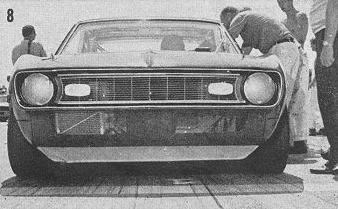
Ford's tunnel-port configuration, too, is not in what one could call universal supply, but why quibble - the hotter the competition, the hotter the interest generated in the series. Like Chevy, Ford had elected to preview a little of next year's bag with their two team cars, the one piloted by Titus and the other by Horst Kwech, sported subtle changes in cam and cylinder chamber to be used, presumably, with their own version of the porqupine. And the Javelins, poor chaps, finally got the rest of what the others had had all along, a cold-air package for their cross-ram manifold which comes right off Vic Edelbrock's shelf. On the grid, the power rating game looked like this: Donohue, 455-50 @ 7000 rpm; Ford, 440 @ 8000 rpm and Javelin, 435 @ 7000 rpm.
And then there was the strange case of the Canadian Pontiac. Because of the funny manufacturing setup GM has between Canada and the U.S., Canadian Pontiacs are sold with Chevy engines in some models. Nobody thought much about this until Trans-Am racing began and this year someone from Pontiac filed papers with FIA to get the Canadian Firebird homologated for competition. As we all know, Pontiac does not have an engine, except their OHC 6, that falls into the 305-inch displacement limit. But since Canadian Firebirds come with Chevy engines, Chevy's nifty Z-28 is eligible. Sure, Pontiac did not cherish the notion of racing with Chevy power but it made the car competitive right off the bat for anyone who wanted to run it. Toronto, Ontarian Terry Godsall wanted to race. He hired driver Craig Fisher and imported an Al Bartz 304 Chevy that put out nearly the same power as Donohue's. By this time Chevy had become incensed to the point of issuing a bulletin to dealers not to sell their hot cross-ram manifold to Firebird owners but Godsall managed to bluff his way through.
At the beginning of July the car was ready. It finished fourth the first time out at Meadowdale, Illinois. Four races later, Fisher came in second behind the Sunoco Camaro and a week later Jerry Titus announced he was leaving Ford to become President of T/G Racing (Titus/Godsall), a Pontiac team effort similar in concept to the Penske operation but far more ambitious. T/G's scheme is to build 14 Firebirds for next season, three for the T/G Team and the rest for sale at under $15,000 ready-to-go, cheaper than you can build one yourself. The engine will not be a Chevrolet but some type of existing Pontiac powerplant, scaled down in displacement but hotted up in performance by Al Bartz who will implement the test program. So the Trans-Am goes on to '69 with more new blood marching to the beat that competition sells cars.
Gatorade is what everybody needed at race time. That's the stuff some doctors dreamed up for the University of Florida football team to permit prolonged strenuous exercise in high temperatures without danger of heat prostration. The lemonade looking liquid replaces perspiration and body salts and is absorbed by the system 12 times faster than water. George Follmer estimated that you could put about 10 degrees on whatever the track temperature was to get the cockpit reading. It was 104 in the shade. Follmer's teammate, Peter Revson, an Easterner obviously suffering from the heat, swigged down a glass of Gatorade, sucked on a carrot and it helped. Ah, how technical race preparation becomes.
The Mission Bell 250 clanged off 13 minutes late and Donohue breezed into the lead pulling steadily away from Titus who pulled steadily away from the rest of the pack. Donohue continued inexorably to inch ahead until lap 12 when Jerry zoomed up on his bumper and passed him on the outside of turn 9, squirting away like a grasshopper. As you know, grasshoppers don't squirt too far for sustained bursts and neither did Titus, crashing the engine two laps later. Unruffed, Donohue whirred on.
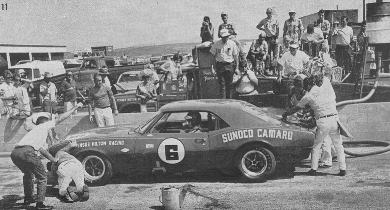
One look at a Penske pit stop and you know why they won all those races. Suddenly, the Wood Brothers have an authorized instant service branch outlet in Pennsylvania. Penske may even be one up on the Brothers with a kind of drag racer's super cool-can, a 30-gallon fuel tank mounted inside a 55-gallon drum and packed with acetone and dry ice to keep the 260 Sunoco fuel at 42 degrees F. On a hot day, fuel contraction is such that 23 gallons can be pumped into a 22-gaIlon tank. The advantage Donohue gets from the cool fuel is difficult to calculate since his Camaro holds the track record for gas gulping as well as speed but he might otherwise be seriously handicapped.
The intense heat exacted a terrible toll. Temperature and oil pressure gauges replaced the tachometer as a speed governor-the higher the former got, the lower the latter became and the slower you went. Follmer dropped out after Titus with the bottom of his chassis covered with oil and remarked tersely, "My engine got hot, too hot." With two rapid pit stops of 10 and nine seconds behind, Donohue's seemingly invincible machine began smoking and finally retired on lap 60 with a burned piston. A surprised Horst Kwech inherited the lead in the second team Mustang, Revson was second and Fisher in the Firebird was third. The order remained unchanged to the finish.
Undoubtedly, Fisher's performance was one of the highlights of the meeting. Forced to start in 32nd position because he burned a piston during practice and never qualified, Craig fired up the new engine Godsall's crew had installed overnight, and slithered through traffic like a Japanese taxi driver. When the checkered flag fell, Fisher was running stronger than Kwech or Revson but couldn't quite make up the distance. Second contender for outstanding effort was Jon Ward, a young sprint and stock car driver from Saugus, Calif., who bought his own Camaro, built it according to the SCCA rule book without ever seeing one of Penske's, and finished an amazing 4th overall. Yes, Virginia, like Pete Estes says, Z-28 Camaros are competitive off the assmebly-line.
Just to keep everybody honest, SCCA elected to have the first four cars in each class torn down and to everyone's credit, no irregularities were found. In retrospect, AMC was still eight points behind Ford and the battle to be No. 2 would have to go right down to the wire at Kent. As the sun slid down the western sky people wondered if AMC would lose in the end, what Pontiac's fortunes would be, and if Australian Horst Kwech, whose steady going in the Mustang had kept Ford alive, might be the next star on the horizon. It's been a weird year. /MT
Order of finish: 1 - Horst Kwech, Mustang - average speed, 94.9 mph; 2 - Peter Revson, Javelin; 3 - Craig Fisher, Firebird; 4 - Jon Ward, Camaro; 5 - Vic Provenzano, Alfa Romeo; 6 - Fred Baker, Porsche; 7 - Malcolm Starr, Mustang; 8 - Ron Bucknum/Dan Parkinson, Camaro; 10 - Del Taylor/Check Towbridge, Alfa Romeo.
1968 Trans-Am Season finishes for AMC Javelin
Sebring - 5th place
War Bonnet - 2nd place
Lime Rock - 3rd place
Mid Ohio - 3rd place
Bridgehampton - 2nd place
Meadowdale - 2nd place
St. Jovite - 2nd place
Bryar Park - 2nd place
Watkins Glen - 4th place
Continental - 5th place
Riverside - 2nd place
Kent - 5th place
American Motors takes a record - the only manufacturer's entry to finish every race entered.
Championship = Chevrolet Camaro
2nd Place = Ford Mustang
3rd Place = AMC Javelin

